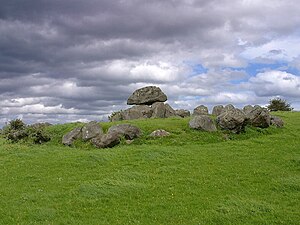Carrowmore
| An Ceathrú Mór | |

Tomb 7 at Carrowmore, a passage tomb within a boulder circle.
|
|
| Location | County Sligo, Province of Connacht |
|---|---|
| Region | Atlantic Megalithic Zone |
| Type | Passage tomb complex |
| Length | 1 km |
| Width | 600 metres |
| History | |
| Material | Gneiss, Quartzite |
| Founded | 3700-2900 BC |
| Periods | Neolithic |
| Cultures | Irish Passage Tomb Tradition |
| Site notes | |
| Excavation dates | 1977-1980, 1994-1998 |
| Condition | Partially preserved |
| Ownership | Public and private |
| Management | Admission Fee |
| Public access | Yes |
Coordinates: 54°15′03.08″N 8°31′09.00″W / 54.2508556°N 8.5191667°W
Carrowmore, County Sligo (Irish: An Cheathrú Mhór, meaning Great Quarter) is one of the four major passage tomb complexes in Ireland. It is located at the geographical centre of the Cúil Irra peninsula in County Sligo and 3 km west of Sligo town.
This is one of the largest (in terms of number of monuments) complexes of megalithic tombs in Ireland and is also among the oldest used passage tombs, the earliest depositions approximately 3700 BC.
Placed on a small plateau at an altitude of between 36.5 and 59 meters above sea level Carrowmore is the focal point of a prehistoric ritual landscape which is dominated by the mountain of Knocknarea to the west with the great cairn of Miosgán Médhbh on top. To the east is Carns Hill with two large cairns overlooking Lough Gill, and along the eastern boundary of the peninsula the Ballygawley Mountains have four passage tombs at their peaks.
30 monuments survive in Carrowmore today. There may have been more monuments in the complex originally, but some fell victim to quarrying and field clearance during the 18th, 19th and early 20th century. The complex is about one kilometre north-south and 600 meters east-west. Most of the sites are "satellite tombs" which surround the largest monument, placed on the high point of the plateau, the cairn (now restored) called Listoghil.
...
Wikipedia
